The Key Differences Between Hard Seltzer And Beer
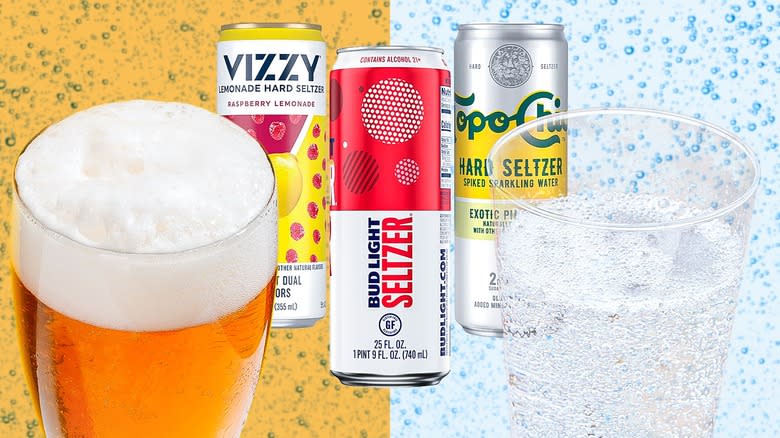
Unless you've been living under a rock for the past 10 years, you've likely noticed hard seltzers coming onto the drinking scene in a big way. It used to be that you'd go to a bar and order yourself one of the four light beers on draft, nothing too fancy about it. Nowadays, consumers have many more options, with new innovations trickling in all the time. Through the haze of the party, you may have finally asked yourself what it is that you're really drinking when you down a hard seltzer. Is it actually just beer in disguise?
Hard seltzers aren't beer, but they honestly aren't as different as you might think just by tasting them. They've got almost the same alcohol contents, they're both carbonated, and you can sip them just as easily as you can shotgun them. But while they may occupy similar slots in the party toolbelt, it's pretty clear that there's something different going on under the hood. After all, beer often has a slightly bitter, malty taste to it whereas hard seltzers tend to taste like a fruity sparkling soda water. Something must be going on behind the scenes that's responsible for this flavor difference.
Read more: 15 Popular Hard Seltzer Brands, Ranked Worst To Best
What Is Hard Seltzer?
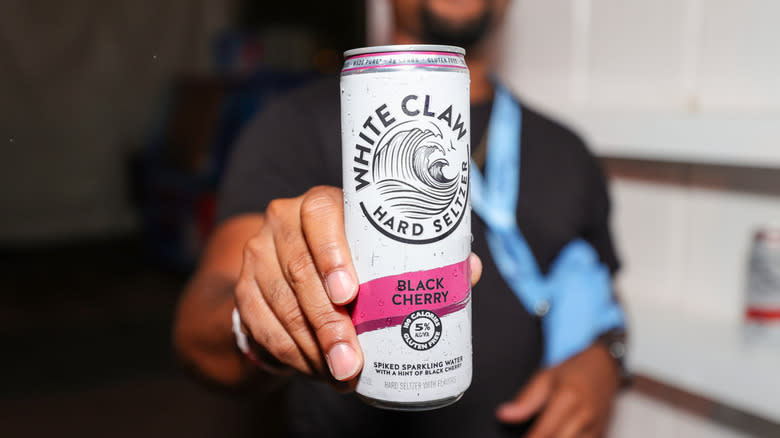
The first commercially available hard seltzer is credited to Coors Brewing Company with its 1993 release of Zima. Contemporary hard seltzers are quite a bit different from that initial release, but the drink was clear, carbonated, and flavored with citrus. It enjoyed a brief heyday in the spotlight but quickly fell out of favor, probably due to the fact that it tasted like garbage. Zima was actually a filtered beer with citrus flavorings, which isn't the case for modern hard seltzers. Talking about today's hard seltzers gets surprisingly complicated right off the bat.
When we talk about the most popular hard seltzer brands, we're often talking about two different drinks. Hard seltzer proper includes brands like White Claw and Truly, but you also have drinks like High Noon that taste similar and have identical marketing tactics and packaging. Nevertheless, these drinks are more accurately described as canned cocktails since the company's main product line is essentially a vodka and soda with flavorings. We're not going to pretend to be the authority on whether High Noon and other brands like it are actually hard seltzers or not -- instead, we'll be focusing on the White Claws of the world to avoid confusion.
What Is Beer?
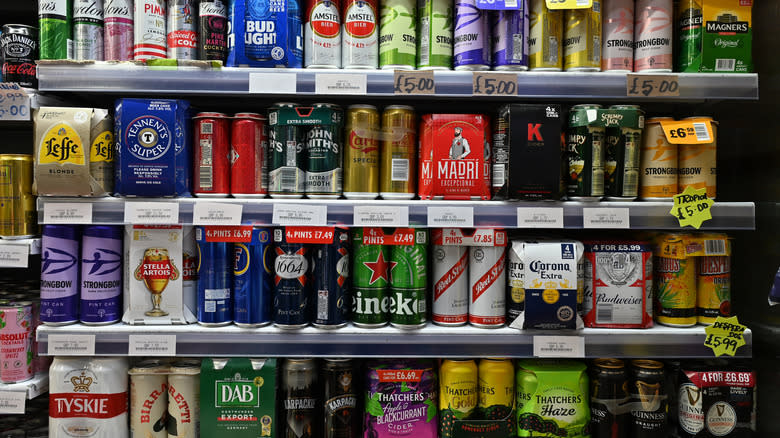
Beer is a much older recipe than hard seltzer. Hard seltzer boasts a measly three decades, whereas beer goes back before history was invented. There are traces of beer in the Middle East that date back to 3,400 B.C., but there's good reason to believe that the practice of brewing beer goes back thousands of years before that. The pint of frothy you're swigging at the bar probably tastes quite a bit different from those early versions, but a fermented grain beverage by any other name is still a fermented grain beverage.
As the craft beer scene has so wonderfully proven, there's a huge range in what beer can be. You've got many types of beer available at breweries, including sours, hazies, pale ales, porters, lagers, stouts, and Belgian wheats – and the list goes on and on. At its core, though, beer is an alcoholic drink made from fermented grain that hasn't been distilled. It typically sits somewhere between 4% and 10% alcohol, though some beers fall outside that range.
While modern beer does have a number of sub-genres to choose from, beer can be generally described as a carbonated drink with a slightly sweet, slightly bitter flavor profile. A professional cicerone may have more to say on the topic, but it's good enough for our purposes.
Beer Is Typically Made With Malt
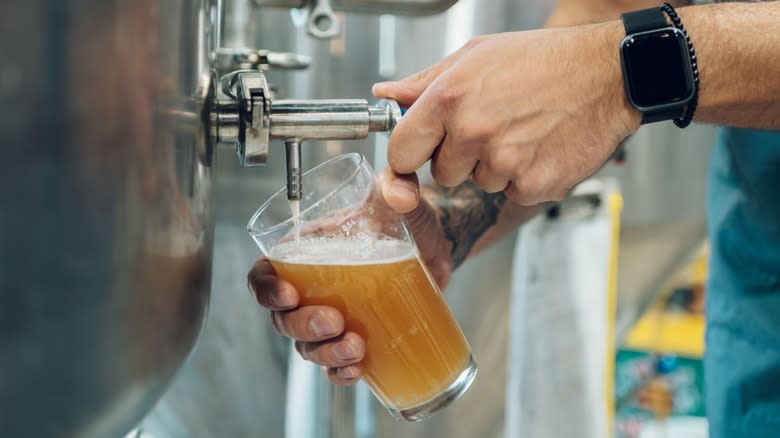
Now that we have a vague outline of what we're talking about when it comes to hard seltzers and beer, we can get to the meat of the matter. The most important difference between the two drinks comes down to how each one is made. The underlying chemical process that produces alcohol is the same for all the different alcoholic beverages that we enjoy: Yeast feeds on sugar and creates ethanol and carbon dioxide in its place. But it's the source of the sugar that makes wine different from whiskey and hard seltzer different from beer.
Legally speaking, hard seltzers are considered "flavored malt beverages," but why that would be the case isn't clear since there's no actual malt involved. Beer is made from malt, hops, yeast, and water. Just as a refresher, malt is malted barley, which is the source of the sugar that the yeast will consume to turn the drink alcoholic. There are some beers that swap the malt for wheat, but malt is typical.
On the other hand, hard seltzers are made from water, sugar, and yeast – no grains, here. The sugar used is often cane sugar and it's mixed with water to create a sweet bath for the yeast to float around in. With so few ingredients, one of the biggest mysteries about hard seltzers is why they are so expensive. They're considerably cheaper to produce than beer, so the premium price point may just boil down to good marketing and high demand.
Hard Seltzer Flavors Are Added After Brewing
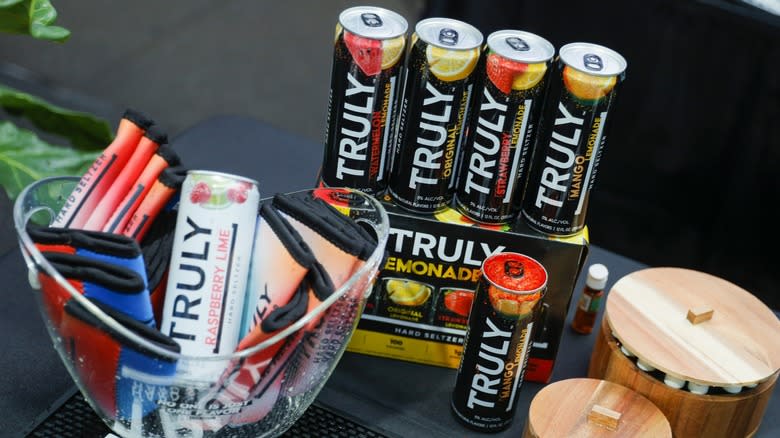
Both beer and hard seltzers come in a variety of flavors, but how they get there isn't the same. For beer, looks and taste depend primarily on the malt and the hops used to produce it. For darker beers like porters and stouts, the malt is roasted before fermentation. This gives the beer its darker hue and provides the caramel sweetness that we know and love. Hops offer a bitter tinge to beer and different varieties of hops provide different flavors. IPAs are known to be hop-heavy, giving them the harsh bite that hipsters are looking for. Sour beers are something of an exception since their flavor comes from adding multiple strains of yeast for extra acidity and fruit acids are also used as flavorings to make the beer tart.
Hard seltzers don't have the luxury of extracting flavor from their ingredients. In fact, a flavorless base is the goal since the producer can then add flavorings of any kind to get the drink to taste like anything they want. Guava, black cherry, and pineapple are some typical flavors you might see in brands such as White Claw and Truly. Most hard seltzers aren't flavored with actual fruit juice, though a few exceptions do exist. The biggest challenge in making hard seltzer is getting the flavor just right, so producers are pretty tight-lipped about how exactly they achieve their signature taste. But the process is pretty similar to how the flavor essences in non-alcoholic seltzer are created. They're basically essential oils and distillates of fruits and herbs.
Hard Seltzers Are Marketed As Healthier Alternatives
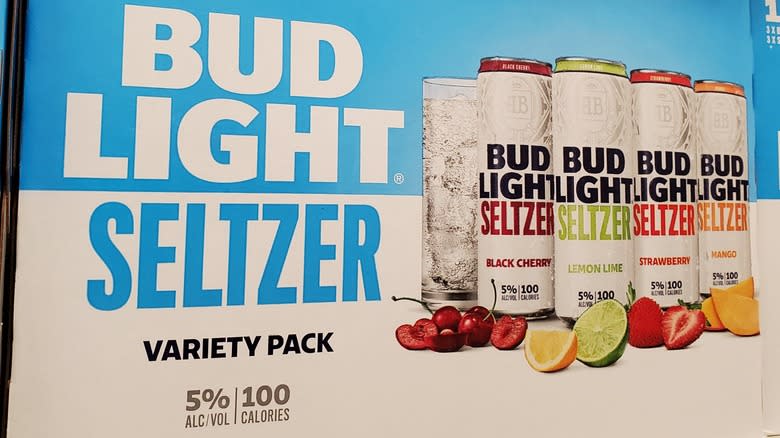
Hard seltzer companies perpetuate the idea that their beverages are a healthier alternative to beer and other alcoholic drinks. The claim is misleading, but the perception is real, so we figured we would include the health differences to clear up any confusion. A big selling point for hard seltzers is that they have a low calorie count. Even if having fewer calories meant the same thing as being healthier -- which it doesn't -- hard seltzers aren't uniquely healthy for being low-calorie.
All alcoholic drinks get their calorie count directly from the alcohol content. The higher the alcohol by volume (ABV), the more calories the drink has. So, when hard seltzers claim to be low-calorie, all they are really saying is that they have less alcohol than other drinks – which isn't necessarily even true. There are plenty of light and low-carb beers that have just as much alcohol -- and just as many calories -- as hard seltzers.
Hard seltzers were invented because of the health craze in the 1990s surrounding clear liquids. The logic was that if you could see through it, that meant there was nothing hiding inside. This might make sense visually, but it doesn't make sense nutritionally. A glass of water is still clear if you dissolve 3 cups of sugar into it. The nutritional hype is exclusively a marketing tactic. But you weren't really drinking for the health benefits anyway, so there's no need to get down about it. Party on -- just don't count your fifth Truly toward your daily fruit intake!
Read the original article on Tasting Table.

